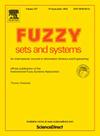关于一般阶的最大函数
IF 2.7
1区 数学
Q2 COMPUTER SCIENCE, THEORY & METHODS
引用次数: 0
摘要
在决策中,最大函数用于最坏情况和最佳情况评估。极大性产生了丰富的结构,在点向顺序的上下文中得到了很好的研究。在本文中,我们研究了一般预定函数的极大性,并给出了这类函数的一个表示定理。文中给出了不同随机阶数的结果,包括一般随机阶数、凸/凹递增阶数和色散阶数。本文章由计算机程序翻译,如有差异,请以英文原文为准。
Maxitive functions with respect to general orders
In decision-making, maxitive functions are used for worst-case and best-case evaluations. Maxitivity gives rise to a rich structure that is well-studied in the context of the pointwise order. In this article, we investigate maxitivity with respect to general preorders and provide a representation theorem for such functions. The results are illustrated for different stochastic orders in the literature, including the usual stochastic order, the increasing convex/concave order, and the dispersive order.
求助全文
通过发布文献求助,成功后即可免费获取论文全文。
去求助
来源期刊

Fuzzy Sets and Systems
数学-计算机:理论方法
CiteScore
6.50
自引率
17.90%
发文量
321
审稿时长
6.1 months
期刊介绍:
Since its launching in 1978, the journal Fuzzy Sets and Systems has been devoted to the international advancement of the theory and application of fuzzy sets and systems. The theory of fuzzy sets now encompasses a well organized corpus of basic notions including (and not restricted to) aggregation operations, a generalized theory of relations, specific measures of information content, a calculus of fuzzy numbers. Fuzzy sets are also the cornerstone of a non-additive uncertainty theory, namely possibility theory, and of a versatile tool for both linguistic and numerical modeling: fuzzy rule-based systems. Numerous works now combine fuzzy concepts with other scientific disciplines as well as modern technologies.
In mathematics fuzzy sets have triggered new research topics in connection with category theory, topology, algebra, analysis. Fuzzy sets are also part of a recent trend in the study of generalized measures and integrals, and are combined with statistical methods. Furthermore, fuzzy sets have strong logical underpinnings in the tradition of many-valued logics.
 求助内容:
求助内容: 应助结果提醒方式:
应助结果提醒方式:


